Saab SK 60 times three! Part III: Saab SK60B /60083 of the 3rd Squadron "Urban Gul" of F21 Wing and my experience with Pilot Replica's long awaited kit!
The Saab SK60/Saab 105 occupies a prominent position in the history of aviation. Its very origin as a project for a civilian four-seater business jet gives it a special status. What is particularly interesting, however, is that it was produced by a country that, in the midst of the Cold War, attached great importance to a neutral stance on defence procurement. However, the agile jet was not only intended to supply its own "Flygvapnet" with a light passenger transport and training aircraft, but was also intended for export. In the end, however, it remained with a single customer: Austria, which was also neutral, used the versatile two-seater - designated here as the Saab 105OE - for over 50 years in its intended roles as a trainer and light ground fighter as well as for air surveillance. In Sweden itself, the remaining examples of this remarkable jet are still in service with Flygvapnet following a final modernisation in 2020. Although its retirement is already scheduled for 2025, the SK 60 certainly doesn't have to worry about its status as one of the icons of the Swedish aircraft industry!
With this in mind, it seems fitting that it was a manufacturer from Sweden that brought the long-awaited first kit of this aircraft in the popular 48th scale onto the market in 2022. Pilot Replicas has now built up a solid reputation as a manufacturer of high-quality - and, it has to be said, quite expensive - kits with a manageable number of models. The model selection is naturally focussed on the exciting topic of Swedish own-built models. The Saab SK 60 kit presented here will undoubtedly further strengthen the good reputation that Pilot Replicas has built up with the Saab J21 and J29 Tunnan kits, even if the one or other hurdle that this product presents to the modeller in the otherwise well-paved path to a pleasurable building experience needs to be mentioned!
The equipment
But that's not where I want to start - especially as the kit has a lot to be pleased about! The first thing that comes to mind is the solid equipment of the kit, which is supplied in a pleasantly sturdy folding box. In addition to the detailed plastic parts, there is a large etched parts board, although its massiveness means that it is just on the edge of what is desirable. The large number of aerials to be found on it should not frighten anyone, because obviously the equipment of all SK 60/ Saab 105 versions has already been taken into account here. Only a few parts are used for the SK60 A and B shown here. What both the etched parts sheet and the decal sheet lack is a representation of the belts of the two ejection seats.
The decals for the four marking variants offered are of first-class quality. The extensive and carefully crafted sheet was designed by "Moose Republic Decals", while Cartograph took care of the printing. Both names promise high quality in all relevant categories, which, I can say from my experience with the three kits, is also honoured.
The plastic parts
I really liked the moulding of the plastic parts. The recessed and raised rivets and the depth and precision of the panelling lines, which are important for this aircraft, seem to me to be coherent. The detailing of the clearly visible cockpit probably corresponds to the usual expectations for this scale, but still offers plenty of scope for the ambitious friend of improvement. This applies in particular to the representation of the two ejection seats: whether the moulded belt reliefs are sufficient here or whether you should make your own.
The accuracy of fit can generally be described as very good. Exceptions prove the rule, as we all know: the fit of the front canopy clear section on the fuselage is indeed given, but still has to be reworked: the original shows a flush and smooth transition from the fuselage contour to the canopy frame. The model has a well-fitting windscreen without modification, but this is separated from the fuselage by a gap. This this needs to be repaired with filler.
Part layout and building instructions
By now I know that you can expect a change from the usual when building a Pilot Replica model. This is also true here: the usual two fuselage half-shells, which, when joined together, essentially form the aircraft fuselage, are not to be found here. On the other hand, you have to join six components together to arrive at an initial approximate fuselage shape. Things get really playful in the following construction section in the centre fuselage area. Here you will find 24 parts that are necessary to create the engine cowling and the visible parts of the turbines alone. Once you have understood the underlying layout, however, you can quickly build the complex structure. However, the building instructions do not really make this easy!
Personally, I don't always find the graphic form of the instructions helpful. The illustrations of the parts seem to come from the 3D design programme, which results in beautifully rendered but sometimes not clearly assignable graphics. This is exacerbated by the similarity of colour code and part number: there is a high risk of confusion here, which affects the clarity of the instructions and makes searching for the correct parts a bit tedious
From time to time I was at a loss as to what should be put together and how, and once I even had to detach parts that had been glued together incorrectly. A solution was then found by trying out how things could fit together - but this does not give the assembly instructions a good report card. It is advisable to check the numbering of the parts used in steps 11 and 12 carefully. In my opinion, they are numbered incorrectly. I would also like to warn you about a suggestion in the instructions: in the very first building step, you are asked to fit parts 74/75 and 71/68 - which you should definitely not do. These delicate struts (in the original they hold the undercarriage doors away from the extended undercarriage) will certainly break off and possibly be lost if they are fitted right at the beginning. There is no disadvantage in fitting these struts at the very end, which is what I did.
The original: Saab SK60B /60083
The Saab SK60 shown here flew in 1976 with the 3rd Squadron "Urban Gul" of the F21 Wing in Lulea near the Finnish border on the Gulf of Bothnia.
A special feature of this model is the use of two after market-ejection seats and the two air brakes on the fuselage, which are shown deployed. The seats are from Pilot Replicas, the air brakes from Wolf 3D Resin Parts. I can recommend the use of these two upgrade parts, if the canopy is shown open or if you want to show the Saab-typical air brakes extended, the filigree appearance of the resin parts results in a significant improvement over the original parts.
A final assessment of the kit is generally positive. The accuracy of fit, features and detailing of the outer hull are particularly pleasing. I also find the unusual complexity of the parts structure to be an interesting change, but I see room for improvement in the design of the assembly instructions and the detailing of the cockpit and seats.
However, it is undoubtedly nice and welcome that the SK 60 from Pilot Replicas finally offers the long-awaited opportunity to build this highly interesting trainer in attractive marking variants and put it in the display case. I would like to thank Pilot Replicas for this!
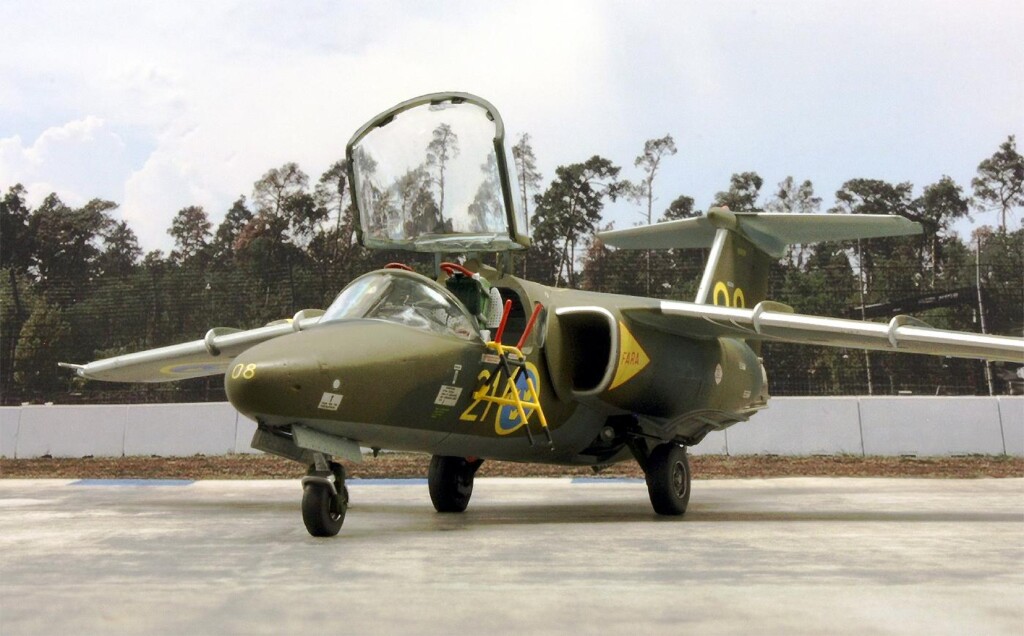
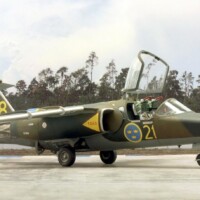
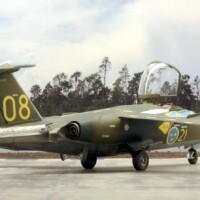
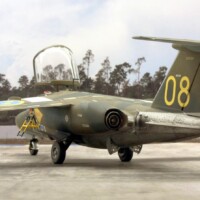
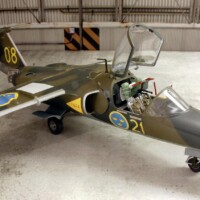
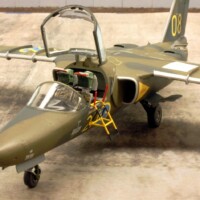
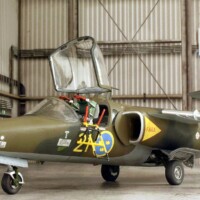

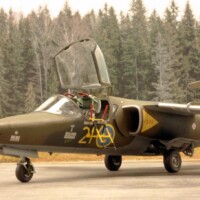
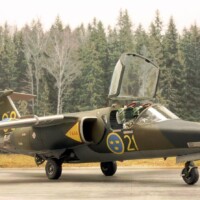

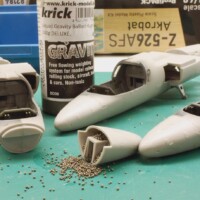
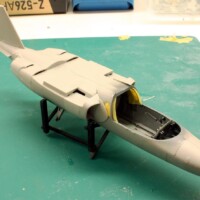
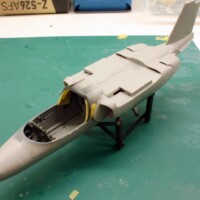

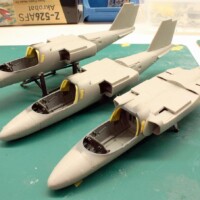
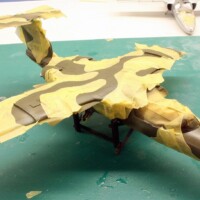
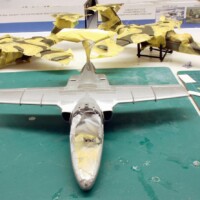
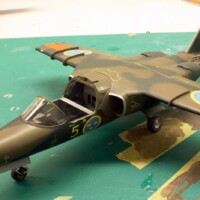
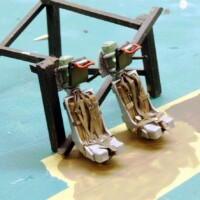

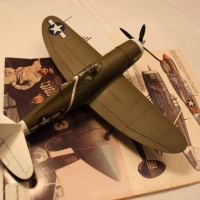


Great results on all three SK 60, Roland! Good comments on the construction issues and what to keep an eye on.
Interestingly the SK 60 never got a name like other Saab aircraft: Gripen, Viggen, Draken, Lansen, Tunnan, Safir, Scandia, Supporter, Safari. The name Florett (Swedish for foil, the sword type) was never implemented for SK 60. The J 21 nor the B 17 ever got a name either. Passenger prop liners 340 and 2000 never got names unless Argus counts for the military 340 recce plane version. The Saab Sonett, a car model, got a name, though.
"Urban Gul" is referring to the F 21 wing as U is the 21st letter in the alphabet, gul is yellow and the designated colour for the third squadron. The other would be red/röd and blue/blå for first and second squadrons.
Pilot replicas is a small scale company operating from a garage, sort of, and mainly producing odd Swedish aircraft models. This will be reflected in the price. A J 21 will never be able to compete on equal terms to another Bf 109 in 1/48...
Speaking of Pilot replicas and their model range. PR has now launched the latest model, a long awaited for DH Vampire trainer, in 1/48. It comes in two different boxings, one for a Swedish Sk 28 C and one for a British T.11. Check out the web page for additional details and colour schemes https://www.pilot-replicas.com/collections/aircrafts
Thank you Stellan! Your comment clears up a few key things I've been wondering about - now I have answers! I had figured out that "Gul" means yellow, but it's your explanation of "Urban" that makes the whole thing round and makes sense!
I had figured out that "Gul" means yellow, but it's your explanation of "Urban" that makes the whole thing round and makes sense!
The explanation of the price is of course also correct - in view of the quality and the selection of aircraft, this is certainly justified. Thank you for these informative words!
Glad to be of assistance. Other squadrons would for instance be Gustav Röd for 1st squadron at F 7 wing and Quintus Blå for 2nd squadron at F 17 wing. Here is a list to make it easier to decipher
https://sv.wikipedia.org/wiki/Lista_%C3%B6ver_svenskaflygdivisioner(1936%E2%88%922004)
Definitely helpful, especially because I will stay on the interesting topic "Sweden" - (thanks "Pilot Replicas"
Excellent result and a really nice subject chosen, Roland!
Well done!
Thank you Spiros, your words make me happy!
As beautiful as the others, Roland @rosachsenhofer
Thanks for sharing the building process.
I say thank you very much, John!
Informative write-up and, of course, another very nicely built and finished model, thanks for sharing these with us, Roland.
I really appreciate your words, thank you!
Excellent post - very informative and nice photos!
Thank you for your kind comment!, Chas!
usually they say 'Thrid times a charm', Roland.
In your case, all three are charmers!
Thank you George!
Looks great! I sure wish the manufacturer would release 1/72 renditions! I love all the Swedish aircraft - each is so unique.
You're definitely right! Thank you, Greg!